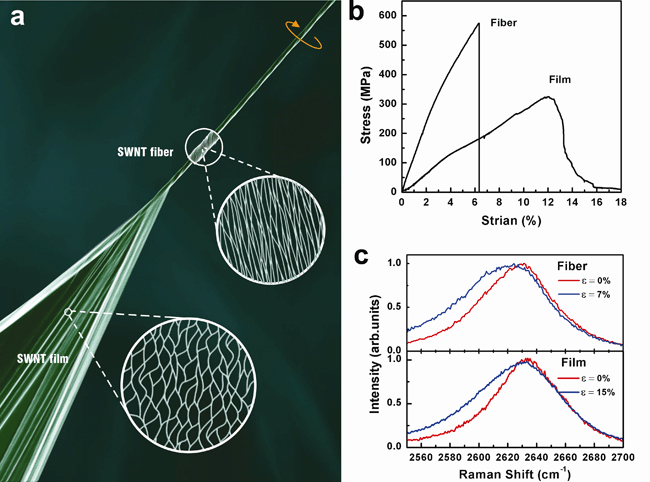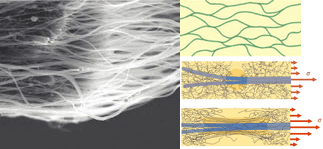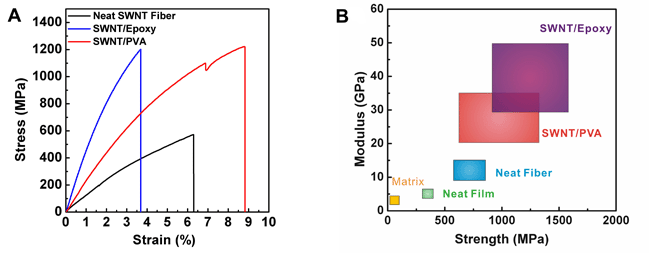The group “Nanometer Materials and Mesoscopic Physics” at the Institute of Physics, Chinese Academy of Sciences, has made a series of important advances in the fabrication of macro-scale single-walled carbon nanotube (SWNT) films and fibers, and in the study of their properties. Prof. Sishen Xie and his students Wenjun Ma et al. have found an effective way to monitor the micromechanical process in macroscale SWNT films and fibers. The results have been published in Advanced Materials (2009, 21, 603-608) and selected as the inside cover of that issue. Their work on continuous SWNT network reinforced composites was published in Nano Lett. (2009, 9, 2855-2861) and was reported by the website of Nature China in Research Highlights under the title “Composites: True strength lies within” (
http://www.nature.com/nchina/2009/090805/full/nchina.2009.157.html).
Rolled from a single- or multi-layer graphite sheet, carbon nanotubes are typical one-dimensional nanomaterials, and have attracted a great deal of attention since their discovery due to their exceptional mechanical properties and promising potential applications. It has been confirmed that the axial mechanical strength of SWNTs approaches the theoretical value of a perfect graphite sheet and is the highest among all presently known materials, which makes SWNTs promising building blocks for fabricating composite materials with excellent mechanical properties. With such attractive prospects, a great deal of effort has been made by many researchers in recent years, but progress has been far below expectation. The real potential of micro-scale SWNTs has not been manifested in macro-scale materials.
To overcome the challenges of macro-scale SWNT structures and their composite materials, Xie’s group conducted a long-term and in-depth study. They were the first to fabricate macro-length SWNT arrays (Nature, 1998, 194, 631) and to measure their mechanical properties. In recent years, cooperating with Zhong Zhang’s group at the National Center of Nanoscience and Technology, they elucidated the micromechanical process in macro-scale SWNT structures by in-situ Raman spectroscopy under stress for the first time. They proposed that the mechanical properties and potential applications of macro-scale SWNT films and fibers can be predicted from the Raman spectra information (Advanced Materials, 2009, 21, 603). On the basis of this work they concluded that: for the recently developed nano-scale reinforced structures based on SWNTs, new load-bearing and transfer structural units need to be designed. To obtain high-performance SWNT reinforced composite materials, the key is to improve the volume fraction and orientation of the tubes and to increase the interface strength. The traditional fabrication process of dispersing nanotubes directly into the polymer matrix, although simple, is not suitable for nano-scale reinforcement. Therefore, new methods are needed to make this new type of material. The synthesis of these composites is based on macro-scale CVD-grown SWNT thin films (Nano Lett. 2007, 7, 2307), with thermoset epoxy resin or thermoplastic poly (vinyl alcohol) (PVA) as polymer matrices to obtain composites through an infiltration process. Highly important, in this new continuous interpenetrating reticulate architecture with strong molecular level coupling, the volume fraction of SWNTs may be controlled in the range of 30~50%, which overcomes the limit of volume fraction in traditional methods. The median strength of the epoxy-infiltrated fibers is as high as 1.6 GPa, which is higher than that of continuous carbon fiber reinforced unidirectional tapes (T300/epoxy) with the same volume fraction of reinforcement. Compared with Bucky paper based high-SWNT-content composites, the tensile strength of this new composite is more than an order of magnitude higher.
Through further studies on the micro-mechanical processes, Xie’s group found that the load transfer efficiency from the macro-strain of composites to the axial strain of SWNTs in this composite was several times that of discrete SWNT reinforced composites prepared by conventional methods. They attributed this to the strong molecular level coupling between the polymer chain segments and the carbon nanotube bundles. The coupling varies with the molecular structure of polymer used, and the simple mixing rules used in the field of traditional composite materials cannot describe this molecular-scale coupling. Based on these discoveries, they introduced an extra factor, the strain-transfer-factor, into the general mixing theory and put forward a new mixing rule suitable for SWNT reinforced composite materials, by which the macro-scale mechanical properties affected by molecular level coupling between the polymer chain segments and the bundles are well described. Their results (Nano Lett. 2009, 9, 2855-2861) not only solve the problem in the preparation and improvement of SWNT reinforced composite materials, but also benefit the studies on other nano-composites.
This research is funded by the Chinese Academy of Sciences, the National Natural Science Foundation and the Ministry of Science and Technology of China.
 |
| Figure 1. Microstructure and mechanical properties of macro-scale SWNT film and fiber. a) Microstructure of macro-scale SWNT film and fiber. b) Tensile curves of macro-scale SWNT film and fiber. c) Raman spectra of macro-scale SWNT film and fiber under stress. |
 |
| Figure 2. SEM image of the new type of SWNT reinforced composite material structure, and schematic of the coupling between the SWNT network and polymer matrix. |
 |
| Figure 3. a) Tensile curves of SWNT composite fibers. b) Comparison of the mechanical properties of the polymer matrix, macro-scale SWNT structure, and composite fibers. |




